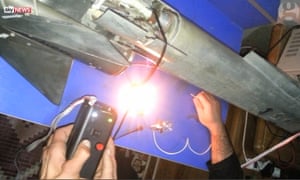Islamic State has built a research centre devoted to launching attacks in the west using driverless cars and rehabilitated anti-aircraft missiles, new footage from inside the terror group reveals.
The centre is in the group’s Syrian stronghold, Raqqa, where technicians from around the world have been plotting to wreak chaos outside of the self-declared caliphate’s borders, according to the group’s own fighters and members of the Syrian opposition, who seized the film from an Isis member in Turkey.
The footage, obtained by Sky News, sheds light on a research and development arm of the organisation that has long been the subject of speculation, but has not previously been confirmed.
It also confirms accounts from Isis members, as well as the fears of European intelligence agencies, that Isis is working to step up attacks in Europe following the co-ordinated bombing and shooting rampage that killed 130 people in Paris in November.
Among the new revelations, which Isis did not intend, are efforts to make defunct surface-to-air missiles operational again by replacing thermal batteries – a feat that has so far been beyond the capabilities of other terror groups.
The footage does not establish that such a goal has been achieved, but it does show the technological ambitions of a group that has carved out its influence inSyria and Iraq through more familiar forms of terror, such as car bombs and suicide belts.

Surface-to-air missiles falling into the hands of Isis, or any terror group, is considered near the top of worst-case scenarios for western and regional officials. Such weapons have been repeatedly demanded by the western-backed Syrian opposition over the past three years of the Syrian war. However, the US has insisted that none be allowed into Syria, fearing that no group could safeguard them.
Among the eight hours of video, which was seized by the Free Syrian Army and passed on to Sky News, is a segment showing Isis members trying to manoeuvre a driverless car. They are also shown busily strapping tape and padding to a mannequin, in the hope it will give off the same heat signature as a human when it passes by imaging scanners, which are often used near sensitive buildings.
Isis’s aim to carry out terror attacks in Europe has steadily been revealed over the past three months, via a rash of propaganda videos that clearly state intended targets. More importantly though, since early last autumn intelligence agencies have found evidence of numerous new plots in the making.
Electronic “chatter”, as well as information from defectors and serving Isis members, underscores that the group is now more intent than ever on exporting chaos to cities such as Rome, Paris, Brussels and London.
In particular, intelligence agencies fear Isis has managed to smuggle a small number of members into Europe. They are intended to act as “sleeper cells” that can train local recruits in how to carry out the attacks. There are fears that the eight hours of captured footage was to be used as a blueprint for attacks and that other members have made it through Turkey and to their destinations.
The seizure of the footage offers a rare unfettered insight into Isis’s capacity to develop its skills, using recruits from around the world. One militant on camera is Turkish. Another is outlining in Russian various forms of explosives that can be turned into bombs once fuses are added.
Over the past year, the Guardian has learned that technicians and scientists from European states have become essential members of the group’s operations, in particular a chemical weapons division, which manufactures poisons and gases and also attempts to weaponise chemicals seized from the Syrian regime, or sold on by corrupt officials.
Turkey had been the main conduit for Isis’s highly prized teams of scientists to cross into its territory. Until about 18 months ago, it was also the main way out.
However, Ankara has since significantly tightened its 500-mile border, making the journey far tougher for militants. Some members of the group do continue to cross the frontier, with the southern cities of Gaziantep, Urfa and Antakya still being frequented by small numbers of Isis operatives, who use them as transit hubs.
The crossing is even more difficult for refugees fleeing northern Syria, many of whom are trapped among the Assad regime, militias that support it, Isis and the myriad armed groups of the Syrian opposition.
[Source:- the gurdian]
